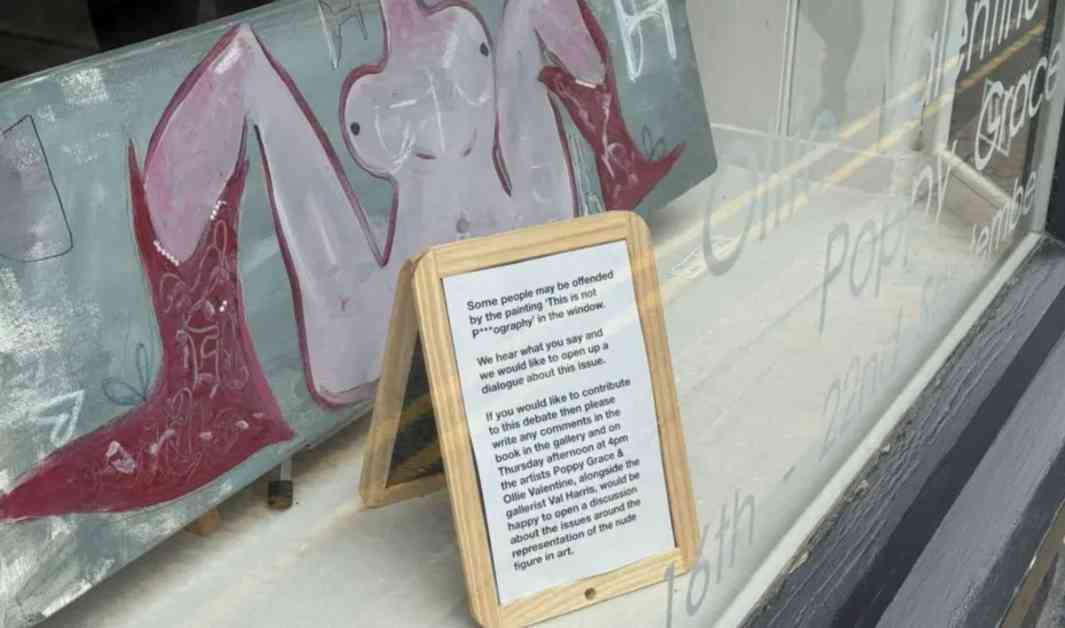Art Gallery Investigation Leads to Controversy Over Display of Alleged Pornographic Art
A Welsh art gallery recently found itself at the center of a heated debate after police visited the premises in response to allegations of displaying “pornographic” material. The controversial artwork in question featured a woman wearing nothing but cowboy boots, with a black triangle strategically placed to preserve her modesty. The piece, which was part of an exhibition at The Table Hay, sparked outrage among some members of the community, leading to a police investigation.
Despite the police visit, gallery curator Val Harris and artist Poppy Baynham stood their ground and decided to keep the artwork on display. They took the opportunity to open up a dialogue about the piece, inviting passersby to share their thoughts in a book titled “This is not p***ography.” The intention behind the artwork was to challenge societal norms and spark conversations about female empowerment and body positivity.
Artist Defends Controversial Painting as a Symbol of Empowerment
Poppy Baynham, the artist behind the controversial painting, expressed her surprise at the backlash it received. She explained that the piece was meant to challenge perceptions of the female body and encourage viewers to question societal taboos surrounding female genitalia. Baynham emphasized that the painting was not intended to be pornographic but rather a statement on female empowerment and the normalization of nonsexual body parts.
In response to critics who deemed the artwork inappropriate, Baynham argued that the painting was a reflection of her artistic expression and should be viewed within the context of the broader conversation it aimed to provoke. She highlighted the importance of destigmatizing female anatomy and challenging traditional gender norms that dictate how women’s bodies should be portrayed in art.
Community Response and Support for Artistic Freedom
Despite the controversy surrounding the painting, many members of the community came forward to defend the artist’s right to creative expression. Supporters of the artwork praised its playful and thought-provoking nature, acknowledging the importance of artistic freedom and the need to challenge societal perceptions of nudity and sexuality.
One supporter, Jessie Dixon, described the painting as exciting and playful, emphasizing that it should not be viewed as a sexual object. Another community member, Dawn Lewis, expressed a similar sentiment, stating that while the artwork may not be to everyone’s taste, it should not be deemed offensive or inappropriate. The outpouring of support for the painting highlighted the diverse perspectives within the community and the importance of fostering open discussions about art and censorship.
In a joint statement on Instagram, the artist and gallery curator reaffirmed their commitment to promoting artistic freedom and challenging societal norms. They emphasized the need to celebrate diversity and embrace nontraditional representations of the human body, particularly in the context of female empowerment and body positivity.
As the controversy surrounding the painting subsided, the gallery announced plans for its upcoming Open Submission Slay Hay Life Drawing Exhibition in October. The event, which invites contributors to submit up to six pieces each, aims to showcase a diverse range of artistic expressions and foster a sense of community among artists and art enthusiasts.
In conclusion, the investigation of the art gallery for allegedly displaying pornographic art sparked a broader conversation about artistic freedom, censorship, and societal perceptions of nudity and sexuality. The controversy surrounding the painting served as a reminder of the power of art to challenge norms, provoke thought, and inspire dialogue. As the art world continues to evolve, it is essential to recognize and celebrate diverse forms of artistic expression while promoting inclusivity and respect for differing perspectives.












